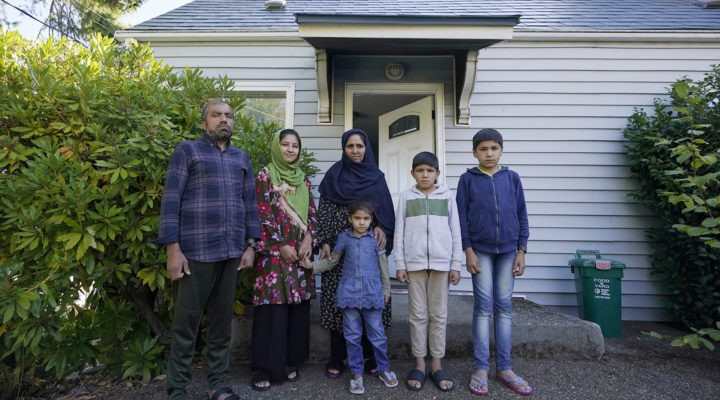Refugee agencies praised the Biden administration’s decision to hike the refugee resettlement cap to 125,000 from 62,500 beginning in October, but added the higher allowance will do little good without assistance in rapidly rebuilding capacity lost during the Trump presidency.

Ali Noorani
“It’s heartening to see the administration take decisive action toward restoring the American tradition of welcome,” said Ali Noorani, president of the National Immigration Forum. “Raising the refugee ceiling will have long-lasting and far-reaching effects for families seeking safety, for the American communities they enrich, and for our position as a standard-bearer in the international community.”
But the goal comes with challenges, Noorani added.
“However, this victory is not without challenges. If we want to live up to our resettlement potential, we need to prioritize rebuilding the capacity of federal agencies and refugee resettlement organizations to ensure they have the resources and support necessary to accept refugees and equip their communities to embrace them,” he said. “The recent outpouring of support nationwide for refugee resettlement must now translate to the congressional action needed to make this a reality.”
In the U.S., nine national agencies work directly with the State Department to resettle refugees already vetted by federal authorities. They range from Church World Service and Episcopal Migration Ministries to the Lutheran Immigration and Refugee Service and the U.S. Conference of Catholic Bishops.
 During the final years of the Obama administration, the U.S. resettled nearly 85,000 refugees, according to the Migration Policy Institute. But the numbers began trailing off significantly as Donald Trump came to office on an “America First” anti-immigration platform. The first year of the Trump administration, the number of refugee admissions dropped by one-third, to 53,716. Then it fell in half again, to 22,533 and by 2020 had halved again, to 11,814.
During the final years of the Obama administration, the U.S. resettled nearly 85,000 refugees, according to the Migration Policy Institute. But the numbers began trailing off significantly as Donald Trump came to office on an “America First” anti-immigration platform. The first year of the Trump administration, the number of refugee admissions dropped by one-third, to 53,716. Then it fell in half again, to 22,533 and by 2020 had halved again, to 11,814.
From beginning to end of the Trump administration, refugee resettlement in the U.S. dropped by 73,000 people — or by 86%.
The Trump administration decimated the workforces of the government agencies tasked with refugee admission, and the sharp declines in admissions then decimated the workforces of the resettlement agencies and the relationships they had built with local landlords, employers, schools, churches and other volunteer groups.
Thus, even when the Biden administration came to office and eventually raised the refugee admission ceiling, there was little infrastructure left in place to make the goal a reality. So far this fiscal year, which is nearly over, barely 6,200 refugees have been resettled in the U.S.
The decline in capacity became increasingly obvious this fall during the ongoing emergency of Afghan refugees, with resettlement agencies scrambling to find apartments, food and volunteers for the estimated 60,000 war refugees suddenly in the pipeline.

Marc and Kim Wyatt
But recent refugee activity suggests the grassroots support the resettlement agencies will need for the fiscal year 2022 refugee influx will emerge, said Kim Wyatt, Cooperative Baptist Fellowship field personnel who minsters to refugees in the Research Triangle of North Carolina.
“We’ve had almost five years of a trickle with the former administration, but those who care about refugees have shown their support for the Afghan evacuees,” she said. That support has included a spike in volunteers and churches donating the use of homes and apartments, furniture, food and money to the Afghan families as they arrive.
“Most people realize how important home is, and they want to befriend someone who has had everything in their lives turned upside down,” she said. “At the end of the day, all of the 125,000 are going to need American friends to walk with them on life’s journey as they establish themselves in this country.”
Further proof that meeting the new, higher refugee cap still will be challenging is the fact that the Biden administration has fallen well short of its 62,500 total for fiscal year 2021, said Krish O’Mara Vignarajah, president of Lutheran Immigration and Refugee Service.

Krish O’Mara Vignarajah
“Understandably, four years of the Trump administration’s assault on the refugee program coupled with pandemic challenges have hamstrung federal rebuilding efforts,” she said. “Raising this cap without dedicating significant resources, personnel and measures to streamline the process would be largely symbolic. It is vital that we see more refugee processing officers out in the field conducting the necessary interviews.
“If the pandemic poses challenges to doing so, the administration should implement 21st century solutions like remote interviews to ensure refugees move through the application pipeline,” she added. “The world has largely adapted to the human realities of COVID-19; we must ensure refugee policy and programming does the same.”
Church World Service went a step further to push for even bolder steps by the White House and Congress.

Erol Kekic
“In response to the growing humanitarian needs for at-risk Afghans and other humanitarian crises, the organization urges the Biden Administration to further expand the refugee admissions goal to 200,000,”said Erol Kekic, senior vice president for the immigration and refugee program. “Today we celebrate a return to moral leadership and our nation’s commitment to welcome and generosity. At long last there is hope for refugees in search of safety, including Afghans who are in imminent danger and thousands of families waiting to be reunited.”
But setting new admissions ceilings is just the first step in the process, Kekic added. “The administration should immediately invest in rebuilding a robust refugee resettlement program. This is an urgent, life-saving humanitarian priority that supports global stability and contributes to making our communities stronger.”
The call for a 200,000 cap isn’t symbolic but necessary “to meet the humanitarian needs for refugees from Afghanistan, Syria, Ethiopia, Democratic Republic of the Congo, Burma and other countries,” Kekic said.
Related articles:
Broad support for helping Afghan refugees does not uniformly extend to all refugees
Refugee resettlement expected to rebound, but the pipeline is broken
Elevated refugee admission goal for year won’t be met, but the trend is upward
Long after the news cycle fades, Afghan refugees will still need our care | Opinion by Samira Page


